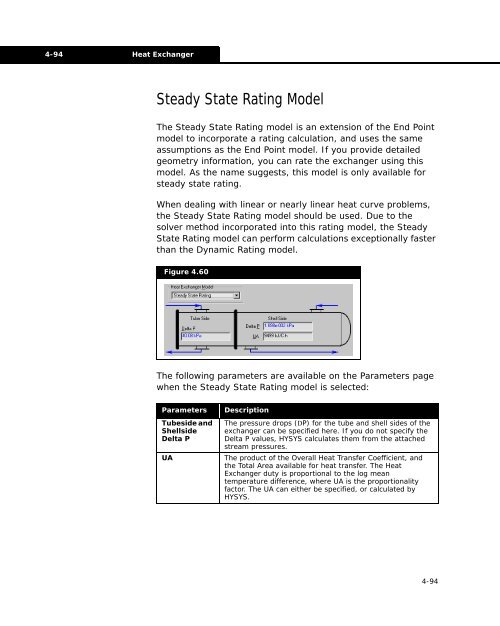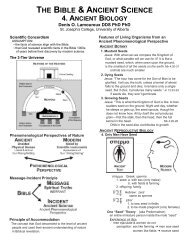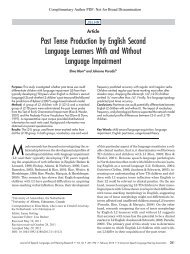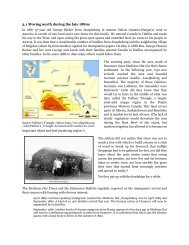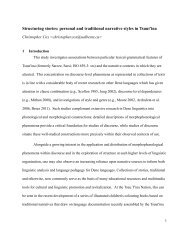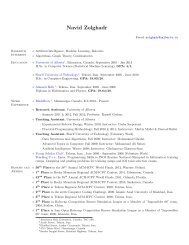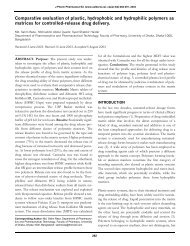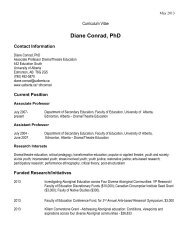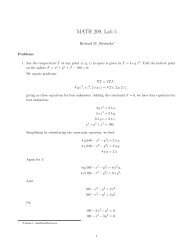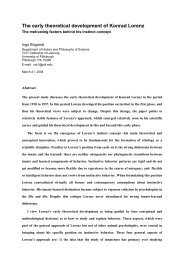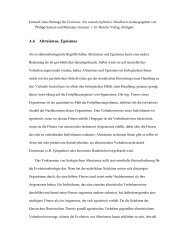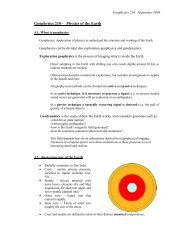Attention! Your ePaper is waiting for publication!
By publishing your document, the content will be optimally indexed by Google via AI and sorted into the right category for over 500 million ePaper readers on YUMPU.
This will ensure high visibility and many readers!

Your ePaper is now published and live on YUMPU!
You can find your publication here:
Share your interactive ePaper on all platforms and on your website with our embed function

HYSYS Operations Guide
HYSYS Operations Guide
HYSYS Operations Guide
Create successful ePaper yourself
Turn your PDF publications into a flip-book with our unique Google optimized e-Paper software.
4-94 Heat Exchanger<br />
Steady State Rating Model<br />
The Steady State Rating model is an extension of the End Point<br />
model to incorporate a rating calculation, and uses the same<br />
assumptions as the End Point model. If you provide detailed<br />
geometry information, you can rate the exchanger using this<br />
model. As the name suggests, this model is only available for<br />
steady state rating.<br />
When dealing with linear or nearly linear heat curve problems,<br />
the Steady State Rating model should be used. Due to the<br />
solver method incorporated into this rating model, the Steady<br />
State Rating model can perform calculations exceptionally faster<br />
than the Dynamic Rating model.<br />
Figure 4.60<br />
The following parameters are available on the Parameters page<br />
when the Steady State Rating model is selected:<br />
Parameters Description<br />
Tubeside and<br />
Shellside<br />
Delta P<br />
The pressure drops (DP) for the tube and shell sides of the<br />
exchanger can be specified here. If you do not specify the<br />
Delta P values, <strong>HYSYS</strong> calculates them from the attached<br />
stream pressures.<br />
UA The product of the Overall Heat Transfer Coefficient, and<br />
the Total Area available for heat transfer. The Heat<br />
Exchanger duty is proportional to the log mean<br />
temperature difference, where UA is the proportionality<br />
factor. The UA can either be specified, or calculated by<br />
<strong>HYSYS</strong>.<br />
4-94
Heat Transfer <strong>Operations</strong> 4-93 The following table describes the parameters available on the Parameters page when the Weighted model is selected: Parameters Description Tubeside and Shellside Delta P The pressure drops (DP) for the tube and shell sides of the exchanger can be specified here. If you do not specify the DP values, <strong>HYSYS</strong> calculates them from the attached stream pressures. UA The product of the Overall Heat Transfer Coefficient and the Total Area available for heat transfer. The Heat Exchanger duty is proportional to the log mean temperature difference, where UA is the proportionality factor. The UA can either be specified, or calculated by <strong>HYSYS</strong>. Individual Heat Curve Details For each side of the Heat Exchanger, the following parameters appear (all but the Pass Names can be modified). • Pass Name. Identifies the shell and tube side according to the names you provided on the Connections page. • Intervals. The number of intervals can be specified. For non-linear temperature profiles, more intervals are necessary. • Dew/Bubble Point. Select this checkbox to add a point to the heat curve for the dew and/or bubble point. If there is a phase change occurring in either pass, the appropriate checkbox should be selected. There are three choices for the Step Type: • Equal Enthalpy. All intervals have an equal enthalpy change. • Equal Temperature. All intervals have an equal temperature change. • Auto Interval. <strong>HYSYS</strong> determines where points should be added to the heat curve. This is designed to minimize error using the least number of intervals. The Pressure Profile is updated in the outer iteration loop, using one of the following methods: • Constant dPdH.Maintains constant dPdH during update. • Constant dPdUA.Maintains constant dPdUA during update. • Constant dPdA. Maintains constant dPdA during update. This is not currently applicable to the Heat Exchanger, as the area is not predicted. • Inlet Pressure.Pressure is constant and equal to the inlet pressure. • Outlet Pressure. Pressure is constant and equal to the outlet pressure. 4-93
4-94 Heat Exchanger Steady State Rating Model The Steady State Rating model is an extension of the End Point model to incorporate a rating calculation, and uses the same assumptions as the End Point model. If you provide detailed geometry information, you can rate the exchanger using this model. As the name suggests, this model is only available for steady state rating. When dealing with linear or nearly linear heat curve problems, the Steady State Rating model should be used. Due to the solver method incorporated into this rating model, the Steady State Rating model can perform calculations exceptionally faster than the Dynamic Rating model. Figure 4.60 The following parameters are available on the Parameters page when the Steady State Rating model is selected: Parameters Description Tubeside and Shellside Delta P The pressure drops (DP) for the tube and shell sides of the exchanger can be specified here. If you do not specify the Delta P values, <strong>HYSYS</strong> calculates them from the attached stream pressures. UA The product of the Overall Heat Transfer Coefficient, and the Total Area available for heat transfer. The Heat Exchanger duty is proportional to the log mean temperature difference, where UA is the proportionality factor. The UA can either be specified, or calculated by <strong>HYSYS</strong>. 4-94
- Page 1 and 2:
HYSYS ® 2004.2 Operations Guide
- Page 3 and 4:
Technical Support Online Technical
- Page 5 and 6:
Phone and E-mail Customer support i
- Page 7 and 8:
4.4 Heat Exchanger ................
- Page 9 and 10:
14.5 Composite Curves Utility .....
- Page 11 and 12:
1-2 Engineering 1.1 Engineering As
- Page 13 and 14:
1-4 Engineering Refer to Section 1.
- Page 15 and 16:
1-6 Operations For detailed informa
- Page 17 and 18:
1-8 Operations For information on t
- Page 19 and 20:
1-10 Operations Refer to Section 1.
- Page 21 and 22:
1-12 Operations HYSYS operations ca
- Page 23 and 24:
1-14 Common Property Views Refer to
- Page 25 and 26:
1-16 Common Property Views contains
- Page 27 and 28:
1-18 Common Property Views It is sh
- Page 29 and 30:
1-20 Common Property Views Tube Bun
- Page 31 and 32:
1-22 Common Property Views Object D
- Page 33 and 34:
1-24 Common Property Views Refer to
- Page 35 and 36:
1-26 Common Property Views • Prop
- Page 37 and 38:
1-28 Common Property Views Object I
- Page 39 and 40:
1-30 Common Property Views Refer to
- Page 41 and 42:
1-32 Common Property Views For more
- Page 43 and 44:
1-34 Common Property Views 4. Fill
- Page 45 and 46:
1-36 Common Property Views Object D
- Page 47 and 48:
1-38 Common Property Views 1-38
- Page 49 and 50:
2-2 Column Operations 2.5.6 Cut Poi
- Page 51 and 52:
2-4 Column Subflowsheet For detaile
- Page 53 and 54:
2-6 Column Subflowsheet Independent
- Page 55 and 56:
2-8 Column Subflowsheet For more in
- Page 57 and 58:
2-10 Column Subflowsheet 3. Specify
- Page 59 and 60:
2-12 Column Theory The following fi
- Page 61 and 62:
2-14 Column Theory It is possible t
- Page 63 and 64:
2-16 Column Theory Refer to Section
- Page 65 and 66:
2-18 Column Theory Basic Column Par
- Page 67 and 68:
2-20 Column Theory Absorber The bas
- Page 69 and 70:
2-22 Column Theory Reboiled Absorbe
- Page 71 and 72:
2-24 Column Theory Partial Condense
- Page 73 and 74:
2-26 Column Installation Refer to S
- Page 75 and 76:
2-28 Column Installation 2.3.2 Temp
- Page 77 and 78:
2-30 Column Installation Refer to t
- Page 79 and 80:
2-32 Column Installation Reboiled A
- Page 81 and 82:
2-34 Column Installation Reflux Rat
- Page 83 and 84:
2-36 Column Installation Using the
- Page 85 and 86:
2-38 Column Property View Refer to
- Page 87 and 88:
2-40 Column Property View When the
- Page 89 and 90:
2-42 Column Property View Monitor P
- Page 91 and 92:
2-44 Column Property View Further d
- Page 93 and 94:
2-46 Column Property View Refer to
- Page 95 and 96:
2-48 Column Property View The Updat
- Page 97 and 98:
2-50 Column Property View Refer to
- Page 99 and 100:
2-52 Column Property View Refer to
- Page 101 and 102:
2-54 Column Property View For more
- Page 103 and 104:
2-56 Column Property View Button Fu
- Page 105 and 106:
2-58 Column Property View Refer to
- Page 107 and 108:
2-60 Column Property View For more
- Page 109 and 110:
2-62 Column Property View Maximum N
- Page 111 and 112:
2-64 Column Property View Refer to
- Page 113 and 114:
2-66 Column Property View Solving M
- Page 115 and 116:
2-68 Column Property View Accelerat
- Page 117 and 118:
2-70 Column Property View Type of C
- Page 119 and 120:
2-72 Column Property View The follo
- Page 121 and 122:
2-74 Column Property View The order
- Page 123 and 124:
2-76 Column Property View column. T
- Page 125 and 126:
2-78 Column Property View For more
- Page 127 and 128:
2-80 Column Property View The Appro
- Page 129 and 130:
2-82 Column Property View For the s
- Page 131 and 132:
2-84 Column Property View Pump Arou
- Page 133 and 134:
2-86 Column Property View 2.4.4 Rat
- Page 135 and 136:
2-88 Column Property View Vessels P
- Page 137 and 138:
2-90 Column Property View The Colum
- Page 139 and 140:
2-92 Column Property View Feeds/Pro
- Page 141 and 142:
2-94 Column Property View Refer to
- Page 143 and 144:
2-96 Column Property View Profile T
- Page 145 and 146:
2-98 Column Property View Profile T
- Page 147 and 148:
2-100 Column Property View Data Con
- Page 149 and 150:
2-102 Column Property View TBP Enve
- Page 151 and 152:
2-104 Column Property View property
- Page 153 and 154:
2-106 Column Property View Editing
- Page 155 and 156:
2-108 Column Property View For more
- Page 157 and 158:
2-110 Column Property View Before a
- Page 159 and 160:
2-112 Column Property View For more
- Page 161 and 162:
2-114 Column Property View Sub-grou
- Page 163 and 164:
2-116 Column Property View Figure 2
- Page 165 and 166:
2-118 Column Property View Equipmen
- Page 167 and 168:
2-120 Column Specification Types Re
- Page 169 and 170:
2-122 Column Specification Types 2.
- Page 171 and 172:
2-124 Column Specification Types 2.
- Page 173 and 174:
2-126 Column Specification Types 2.
- Page 175 and 176:
2-128 Column Specification Types Re
- Page 177 and 178:
2-130 Column Specification Types 2.
- Page 179 and 180:
2-132 Column Specification Types 2.
- Page 181 and 182:
2-134 Column Stream Specifications
- Page 183 and 184:
2-136 Column-Specific Operations Fi
- Page 185 and 186:
2-138 Column-Specific Operations Th
- Page 187 and 188:
2-140 Column-Specific Operations Pa
- Page 189 and 190:
2-142 Column-Specific Operations In
- Page 191 and 192:
2-144 Column-Specific Operations Re
- Page 193 and 194:
2-146 Column-Specific Operations Re
- Page 195 and 196:
2-148 Column-Specific Operations Dy
- Page 197 and 198:
2-150 Column-Specific Operations mo
- Page 199 and 200:
2-152 Column-Specific Operations Re
- Page 201 and 202:
2-154 Column-Specific Operations Fi
- Page 203 and 204:
2-156 Column-Specific Operations Ob
- Page 205 and 206:
2-158 Column-Specific Operations Co
- Page 207 and 208:
2-160 Column-Specific Operations Re
- Page 209 and 210:
2-162 Column-Specific Operations Re
- Page 211 and 212:
2-164 Column-Specific Operations Sp
- Page 213 and 214:
2-166 Column-Specific Operations Re
- Page 215 and 216:
2-168 Column-Specific Operations tr
- Page 217 and 218:
2-170 Column-Specific Operations It
- Page 219 and 220:
2-172 Column-Specific Operations Ob
- Page 221 and 222:
2-174 Column-Specific Operations Sp
- Page 223 and 224:
2-176 Column-Specific Operations Ad
- Page 225 and 226:
2-178 Column-Specific Operations Ea
- Page 227 and 228:
2-180 Column-Specific Operations Pa
- Page 229 and 230:
2-182 Column-Specific Operations Di
- Page 231 and 232:
2-184 Column-Specific Operations Ef
- Page 233 and 234:
2-186 Column-Specific Operations Pr
- Page 235 and 236:
2-188 Column-Specific Operations di
- Page 237 and 238:
2-190 Column-Specific Operations Re
- Page 239 and 240:
2-192 Running the Column Run icon S
- Page 241 and 242:
2-194 Running the Column Refer to E
- Page 243 and 244:
2-196 Column Troubleshooting 2.9.1
- Page 245 and 246:
2-198 Column Troubleshooting repres
- Page 247 and 248:
2-200 References Refer to Section 2
- Page 249 and 250:
3-2 Introduction 3.1 Introduction M
- Page 251 and 252:
3-4 Crystalizer Operation 3.2 Cryst
- Page 253 and 254:
3-6 Crystalizer Operation 3.2.1 Des
- Page 255 and 256:
3-8 Crystalizer Operation Solver Pa
- Page 257 and 258:
3-10 Neutralizer Operation The Crys
- Page 259 and 260:
3-12 Neutralizer Operation If the e
- Page 261 and 262:
3-14 Neutralizer Operation Object D
- Page 263 and 264:
3-16 Neutralizer Operation For more
- Page 265 and 266:
3-18 Precipitator Operation 3.4 Pre
- Page 267 and 268:
3-20 Precipitator Operation Equatio
- Page 269 and 270:
3-22 Precipitator Operation Paramet
- Page 271 and 272:
3-24 Precipitator Operation Refer t
- Page 273 and 274:
4-2 Heat Transfer Operations 4.4 He
- Page 275 and 276:
4-4 Air Cooler The Air Cooler duty,
- Page 277 and 278:
4-6 Air Cooler Air Cooler icon Dyna
- Page 279 and 280:
4-8 Air Cooler Connections Page On
- Page 281 and 282:
4-10 Air Cooler 4.1.4 Rating Tab Th
- Page 283 and 284:
4-12 Air Cooler Refer to Section 1.
- Page 285 and 286:
4-14 Air Cooler The information fro
- Page 287 and 288:
4-16 Air Cooler The group contains
- Page 289 and 290:
4-18 Air Cooler Refer to Section 1.
- Page 291 and 292:
4-20 Air Cooler Criteria Value Airf
- Page 293 and 294:
4-22 Air Cooler The following table
- Page 295 and 296:
4-24 Air Cooler Object Description
- Page 297 and 298:
4-26 Air Cooler Object Description
- Page 299 and 300:
4-28 Air Cooler Object Description
- Page 301 and 302:
4-30 Air Cooler Refer to ACOL Simul
- Page 303 and 304:
4-32 Air Cooler Object Description
- Page 305 and 306:
4-34 Air Cooler The following table
- Page 307 and 308:
4-36 Air Cooler Options Page This p
- Page 309 and 310:
4-38 Cooler/Heater 4.2 Cooler/Heate
- Page 311 and 312:
4-40 Cooler/Heater The relation is
- Page 313 and 314: 4-42 Cooler/Heater Connections Page
- Page 315 and 316: 4-44 Cooler/Heater Heat Loss Page R
- Page 317 and 318: 4-46 Cooler/Heater 4.2.6 Performanc
- Page 319 and 320: 4-48 Cooler/Heater Tables Page The
- Page 321 and 322: 4-50 Cooler/Heater Specs Page The S
- Page 323 and 324: 4-52 Cooler/Heater The Cooler or He
- Page 325 and 326: 4-54 Cooler/Heater Refer to Section
- Page 327 and 328: 4-56 Fired Heater (Furnace) To defi
- Page 329 and 330: 4-58 Fired Heater (Furnace) Heat Tr
- Page 331 and 332: 4-60 Fired Heater (Furnace) dM ( RP
- Page 333 and 334: 4-62 Fired Heater (Furnace) For exa
- Page 335 and 336: 4-64 Fired Heater (Furnace) Fired H
- Page 337 and 338: 4-66 Fired Heater (Furnace) Connect
- Page 339 and 340: 4-68 Fired Heater (Furnace) For mor
- Page 341 and 342: 4-70 Fired Heater (Furnace) The fig
- Page 343 and 344: 4-72 Fired Heater (Furnace) • she
- Page 345 and 346: 4-74 Fired Heater (Furnace) Tube Pr
- Page 347 and 348: 4-76 Fired Heater (Furnace) Duty Pa
- Page 349 and 350: 4-78 Fired Heater (Furnace) Sub pag
- Page 351 and 352: 4-80 Fired Heater (Furnace) 4.3.7 D
- Page 353 and 354: 4-82 Heat Exchanger Refer to Sectio
- Page 355 and 356: 4-84 Heat Exchanger Q loss = heat l
- Page 357 and 358: 4-86 Heat Exchanger If the pressure
- Page 359 and 360: 4-88 Heat Exchanger The Heat Exchan
- Page 361 and 362: 4-90 Heat Exchanger Refer to the TA
- Page 363: 4-92 Heat Exchanger Weighted Model
- Page 367 and 368: 4-96 Heat Exchanger The Basic and D
- Page 369 and 370: 4-98 Heat Exchanger Specifications
- Page 371 and 372: 4-100 Heat Exchanger For more infor
- Page 373 and 374: 4-102 Heat Exchanger Overall When y
- Page 375 and 376: 4-104 Heat Exchanger For a more det
- Page 377 and 378: 4-106 Heat Exchanger The following
- Page 379 and 380: 4-108 Heat Exchanger The tube volum
- Page 381 and 382: 4-110 Heat Exchanger Heat Transfer
- Page 383 and 384: 4-112 Heat Exchanger The Delta P gr
- Page 385 and 386: 4-114 Heat Exchanger Heat transfer
- Page 387 and 388: 4-116 Heat Exchanger Refer to Secti
- Page 389 and 390: 4-118 Heat Exchanger Refer to Secti
- Page 391 and 392: 4-120 Heat Exchanger Parameter Desc
- Page 393 and 394: 4-122 Heat Exchanger Tables Page On
- Page 395 and 396: 4-124 Heat Exchanger Basic Model Th
- Page 397 and 398: 4-126 Heat Exchanger the Heat Trans
- Page 399 and 400: 4-128 Heat Exchanger Dynamic Specif
- Page 401 and 402: 4-130 Heat Exchanger Basic Model Wh
- Page 403 and 404: 4-132 Heat Exchanger The HTFS-TASC
- Page 405 and 406: 4-134 Heat Exchanger Refer to the T
- Page 407 and 408: 4-136 Heat Exchanger Bundle Configu
- Page 409 and 410: 4-138 Heat Exchanger Refer to the T
- Page 411 and 412: 4-140 Heat Exchanger Specification
- Page 413 and 414: 4-142 Heat Exchanger Refer to the T
- Page 415 and 416:
4-144 Heat Exchanger Specification
- Page 417 and 418:
4-146 Heat Exchanger Specific Enhan
- Page 419 and 420:
4-148 Heat Exchanger Refer to the T
- Page 421 and 422:
4-150 Heat Exchanger Refer to the T
- Page 423 and 424:
4-152 Heat Exchanger Refer to the T
- Page 425 and 426:
4-154 Heat Exchanger Refer to the T
- Page 427 and 428:
4-156 LNG 4.5 LNG The LNG (Liquefie
- Page 429 and 430:
4-158 LNG This relation is similar
- Page 431 and 432:
4-160 LNG LNG icon Dynamic Specific
- Page 433 and 434:
4-162 LNG Connections Page The Conn
- Page 435 and 436:
4-164 LNG Heat Leak/Loss Group By d
- Page 437 and 438:
4-166 LNG Specs Page On the Specs p
- Page 439 and 440:
4-168 LNG In the figure below is a
- Page 441 and 442:
4-170 LNG For more information refe
- Page 443 and 444:
4-172 LNG exchanger block. Each zon
- Page 445 and 446:
4-174 LNG Each of the following pla
- Page 447 and 448:
4-176 LNG Internal Heat Transfer If
- Page 449 and 450:
4-178 LNG attached to the LNG unit
- Page 451 and 452:
4-180 LNG The equation used to calc
- Page 453 and 454:
4-182 LNG The Plot Type drop-down l
- Page 455 and 456:
4-184 LNG Refer to Section 1.3.4 -
- Page 457 and 458:
4-186 LNG Main Settings The Main Se
- Page 459 and 460:
4-188 LNG Specs Page The Specs page
- Page 461 and 462:
4-190 LNG Refer to Section 1.3.3 -
- Page 463 and 464:
4-192 LNG 4.5.8 HTFS-MUSE Tab The H
- Page 465 and 466:
4-194 LNG The group located on the
- Page 467 and 468:
4-196 LNG • Heat Load • Design
- Page 469 and 470:
4-198 LNG Field Description Dimensi
- Page 471 and 472:
4-200 LNG The layer pattern itself
- Page 473 and 474:
4-202 LNG The table consists of the
- Page 475 and 476:
4-204 LNG The following table defin
- Page 477 and 478:
4-206 LNG The group consists of the
- Page 479 and 480:
4-208 References Field Description
- Page 481 and 482:
5-2 Logical Operations 5.4 Control
- Page 483 and 484:
5-4 Adjust 5.1 Adjust The Adjust op
- Page 485 and 486:
5-6 Adjust 5.1.2 Connections Tab Th
- Page 487 and 488:
5-8 Adjust For more information, re
- Page 489 and 490:
5-10 Adjust When the Simultaneous S
- Page 491 and 492:
5-12 Adjust iteration status. This
- Page 493 and 494:
5-14 Adjust Before installing the A
- Page 495 and 496:
5-16 Adjust Refer to Section 1.3.1
- Page 497 and 498:
5-18 Adjust Refer to Chapter C2 - S
- Page 499 and 500:
5-20 Balance The Balance Operation
- Page 501 and 502:
5-22 Balance Refer to Section 1.3.5
- Page 503 and 504:
5-24 Balance Heat Balance This oper
- Page 505 and 506:
5-26 Balance basis. Each individual
- Page 507 and 508:
5-28 Boolean Operations For more in
- Page 509 and 510:
5-30 Boolean Operations 3. Double-c
- Page 511 and 512:
5-32 Boolean Operations Refer to Se
- Page 513 and 514:
5-34 Boolean Operations 5.3.2 And G
- Page 515 and 516:
5-36 Boolean Operations 5.3.4 Not G
- Page 517 and 518:
5-38 Boolean Operations 5.3.6 On De
- Page 519 and 520:
5-40 Boolean Operations 5.3.8 Latch
- Page 521 and 522:
5-42 Boolean Operations • Initial
- Page 523 and 524:
5-44 Boolean Operations The output
- Page 525 and 526:
5-46 Boolean Operations To add a ne
- Page 527 and 528:
5-48 Boolean Operations Connecting
- Page 529 and 530:
5-50 Boolean Operations Connecting
- Page 531 and 532:
5-52 Boolean Operations Changing th
- Page 533 and 534:
5-54 Boolean Operations The C&E Mat
- Page 535 and 536:
5-56 Control Ops 5.4 Control Ops HY
- Page 537 and 538:
5-58 Control Ops For more informati
- Page 539 and 540:
5-60 Control Ops Refer to Section 1
- Page 541 and 542:
5-62 Control Ops Refer to Tuning Pa
- Page 543 and 544:
5-64 Control Ops Configuration Page
- Page 545 and 546:
5-66 Control Ops Advanced Page Figu
- Page 547 and 548:
5-68 Control Ops During the setpoin
- Page 549 and 550:
5-70 Control Ops Positional Form Kc
- Page 551 and 552:
5-72 Control Ops In the present aut
- Page 553 and 554:
5-74 Control Ops Scheduling Page Th
- Page 555 and 556:
5-76 Control Ops The alarm points s
- Page 557 and 558:
5-78 Control Ops controller needs t
- Page 559 and 560:
5-80 Control Ops 5.4.3 Ratio Contro
- Page 561 and 562:
5-82 Control Ops Parameters Tab The
- Page 563 and 564:
5-84 Control Ops Tuning Parameters
- Page 565 and 566:
5-86 Control Ops The following equa
- Page 567 and 568:
5-88 Control Ops the specified peri
- Page 569 and 570:
5-90 Control Ops Pv were equal and,
- Page 571 and 572:
5-92 Control Ops For more informati
- Page 573 and 574:
5-94 Control Ops IMC Design Page Th
- Page 575 and 576:
5-96 Control Ops parameters if you
- Page 577 and 578:
5-98 Control Ops Signal Processing
- Page 579 and 580:
5-100 Control Ops For more informat
- Page 581 and 582:
5-102 Control Ops Connections Tab T
- Page 583 and 584:
5-104 Control Ops When PID paramete
- Page 585 and 586:
5-106 Control Ops PV and SP The PV
- Page 587 and 588:
5-108 Control Ops OP ss = steady st
- Page 589 and 590:
5-110 Control Ops • Reverse - Act
- Page 591 and 592:
5-112 Control Ops • Ramp Duration
- Page 593 and 594:
5-114 Control Ops • Use Pv units.
- Page 595 and 596:
5-116 Control Ops region where the
- Page 597 and 598:
5-118 Control Ops Figure 5.74 The p
- Page 599 and 600:
5-120 Control Ops IMC Design Page T
- Page 601 and 602:
5-122 Control Ops You need to speci
- Page 603 and 604:
5-124 Control Ops An example, it is
- Page 605 and 606:
5-126 Control Ops Sample and Hold P
- Page 607 and 608:
5-128 Control Ops For example, if t
- Page 609 and 610:
5-130 Control Ops Monitor Tab A qui
- Page 611 and 612:
5-132 Control Ops 5.4.5 MPC Control
- Page 613 and 614:
5-134 Control Ops Refer to Section
- Page 615 and 616:
5-136 Control Ops The mode of the c
- Page 617 and 618:
5-138 Control Ops PV: Min and Max F
- Page 619 and 620:
5-140 Control Ops Setpoint Ramping
- Page 621 and 622:
5-142 Control Ops The Remote Sp opt
- Page 623 and 624:
5-144 Control Ops value. Similarly,
- Page 625 and 626:
5-146 Control Ops Notice that it is
- Page 627 and 628:
5-148 Control Ops MPC Process Model
- Page 629 and 630:
5-150 Control Ops Field Description
- Page 631 and 632:
5-152 Control Ops MPC Control Type
- Page 633 and 634:
5-154 Control Ops Refer to Section
- Page 635 and 636:
5-156 Control Ops • The CCF file
- Page 637 and 638:
5-158 Control Ops Refer to Section
- Page 639 and 640:
5-160 Control Ops Feed Forward (FF)
- Page 641 and 642:
5-162 Control Ops Object Descriptio
- Page 643 and 644:
5-164 Control Ops Object Descriptio
- Page 645 and 646:
5-166 Control Ops Refer to the DMCp
- Page 647 and 648:
5-168 Control Ops Operation Tab The
- Page 649 and 650:
5-170 Control Ops Refer to Section
- Page 651 and 652:
5-172 Control Ops The Valve Paramet
- Page 653 and 654:
5-174 Control Ops From Utility Flui
- Page 655 and 656:
5-176 Digital Point Digital Control
- Page 657 and 658:
5-178 Digital Point Refer to Sectio
- Page 659 and 660:
5-180 Digital Point Figure 5.120 Au
- Page 661 and 662:
5-182 Digital Point The following i
- Page 663 and 664:
5-184 Digital Point Refer to Sectio
- Page 665 and 666:
5-186 Parametric Unit Operation For
- Page 667 and 668:
5-188 Parametric Unit Operation Con
- Page 669 and 670:
5-190 Parametric Unit Operation Inp
- Page 671 and 672:
5-192 Parametric Unit Operation Fig
- Page 673 and 674:
5-194 Parametric Unit Operation Inp
- Page 675 and 676:
5-196 Parametric Unit Operation For
- Page 677 and 678:
5-198 Recycle Recycle icon 5.7.1 Re
- Page 679 and 680:
5-200 Recycle For more information,
- Page 681 and 682:
5-202 Recycle The Transfer Directio
- Page 683 and 684:
5-204 Recycle Numerical Parameters
- Page 685 and 686:
5-206 Recycle your flowsheet, but a
- Page 687 and 688:
5-208 Recycle For more information
- Page 689 and 690:
5-210 Recycle interconnected and ne
- Page 691 and 692:
5-212 Recycle To access the Recycle
- Page 693 and 694:
5-214 Recycle Recycle Setup Tab The
- Page 695 and 696:
5-216 Selector Block Selector Block
- Page 697 and 698:
5-218 Selector Block Refer to Secti
- Page 699 and 700:
5-220 Selector Block The Inverse Co
- Page 701 and 702:
5-222 Set 5.9 Set The Set is an ope
- Page 703 and 704:
5-224 Set Figure 5.151 HYSYS solves
- Page 705 and 706:
5-226 Spreadsheet Refer to Section
- Page 707 and 708:
5-228 Spreadsheet Refer to the Calc
- Page 709 and 710:
5-230 Spreadsheet Log Function Meth
- Page 711 and 712:
5-232 Spreadsheet For example, supp
- Page 713 and 714:
5-234 Spreadsheet Enumeration in Sp
- Page 715 and 716:
5-236 Spreadsheet • Right-click a
- Page 717 and 718:
5-238 Spreadsheet Refer to Section
- Page 719 and 720:
5-240 Spreadsheet the process varia
- Page 721 and 722:
5-242 Spreadsheet Spreadsheet Funct
- Page 723 and 724:
5-244 Stream Cutter For more inform
- Page 725 and 726:
5-246 Stream Cutter Changing Fluid
- Page 727 and 728:
5-248 Stream Cutter The propagation
- Page 729 and 730:
5-250 Stream Cutter First consider
- Page 731 and 732:
5-252 Stream Cutter Refer to Sectio
- Page 733 and 734:
5-254 Stream Cutter For more inform
- Page 735 and 736:
5-256 Stream Cutter Once you have s
- Page 737 and 738:
5-258 Stream Cutter Imbalance Info
- Page 739 and 740:
5-260 Stream Cutter Refer to Sectio
- Page 741 and 742:
5-262 Transfer Function Combination
- Page 743 and 744:
5-264 Transfer Function Refer to Se
- Page 745 and 746:
5-266 Transfer Function The Operati
- Page 747 and 748:
5-268 Transfer Function Delay Page
- Page 749 and 750:
5-270 Transfer Function Refer to th
- Page 751 and 752:
5-272 Transfer Function 2nd Order P
- Page 753 and 754:
5-274 Transfer Function K = amplitu
- Page 755 and 756:
5-276 Transfer Function Refer to Se
- Page 757 and 758:
5-278 Common Options Refer to Secti
- Page 759 and 760:
5-280 Common Options Figure 5.197 T
- Page 761 and 762:
5-282 Common Options Refer to Chapt
- Page 763 and 764:
6-2 Optimizer 6.1 Optimizer HYSYS c
- Page 765 and 766:
6-4 Optimizer Refer to Section 6.2
- Page 767 and 768:
6-6 Original Optimizer Refer to Sec
- Page 769 and 770:
6-8 Original Optimizer For informat
- Page 771 and 772:
6-10 Original Optimizer Parameters
- Page 773 and 774:
6-12 Original Optimizer 6.2.5 Optim
- Page 775 and 776:
6-14 Original Optimizer BOX Method
- Page 777 and 778:
6-16 Original Optimizer Fletcher Re
- Page 779 and 780:
6-18 Hyprotech SQP Optimizer Refer
- Page 781 and 782:
6-20 Hyprotech SQP Optimizer The St
- Page 783 and 784:
6-22 Hyprotech SQP Optimizer • It
- Page 785 and 786:
6-24 Selection Optimization For mor
- Page 787 and 788:
6-26 Selection Optimization Stochas
- Page 789 and 790:
6-28 Selection Optimization Branch
- Page 791 and 792:
6-30 Selection Optimization The Con
- Page 793 and 794:
6-32 Selection Optimization The bra
- Page 795 and 796:
6-34 Example: Original Optimizer Ma
- Page 797 and 798:
6-36 Example: Original Optimizer
- Page 799 and 800:
6-38 Example: Original Optimizer He
- Page 801 and 802:
6-40 Example: Original Optimizer Op
- Page 803 and 804:
6-42 Example: Original Optimizer Ad
- Page 805 and 806:
6-44 Example: MNLP Optimization Ref
- Page 807 and 808:
6-46 Example: MNLP Optimization The
- Page 809 and 810:
6-48 Example: MNLP Optimization Sin
- Page 811 and 812:
6-50 Example: MNLP Optimization Def
- Page 813 and 814:
6-52 Example: MNLP Optimization Dep
- Page 815 and 816:
6-54 Example: MNLP Optimization 14.
- Page 817 and 818:
6-56 Example: MNLP Optimization 9.
- Page 819 and 820:
6-58 References 6.7 References 1 Bo
- Page 821 and 822:
7-2 Piping Operations 7.4.3 Rating
- Page 823 and 824:
7-4 Compressible Gas Pipe • Energ
- Page 825 and 826:
7-6 Compressible Gas Pipe The Compr
- Page 827 and 828:
7-8 Compressible Gas Pipe For more
- Page 829 and 830:
7-10 Compressible Gas Pipe Refer to
- Page 831 and 832:
7-12 Compressible Gas Pipe Refer to
- Page 833 and 834:
7-14 Compressible Gas Pipe Prior to
- Page 835 and 836:
7-16 Mixer Mixer icon The resultant
- Page 837 and 838:
7-18 Mixer Connections Page On the
- Page 839 and 840:
7-20 Mixer Refer to Section 1.3.6 -
- Page 841 and 842:
7-22 Mixer Refer to Section 1.3.3 -
- Page 843 and 844:
7-24 Pipe Segment Contact your Aspe
- Page 845 and 846:
7-26 Pipe Segment Delta P Method 1:
- Page 847 and 848:
7-28 Pipe Segment Diameter Informat
- Page 849 and 850:
7-30 Pipe Segment U = overall heat
- Page 851 and 852:
7-32 Pipe Segment Figure 7.15 In ad
- Page 853 and 854:
7-34 Pipe Segment Model Horizontal
- Page 855 and 856:
7-36 Pipe Segment Once the flow reg
- Page 857 and 858:
7-38 Pipe Segment Duns & Ros The Du
- Page 859 and 860:
7-40 Pipe Segment Regime Model Stra
- Page 861 and 862:
7-42 Pipe Segment Orkisewski Orkise
- Page 863 and 864:
7-44 Pipe Segment The resulting flo
- Page 865 and 866:
7-46 Pipe Segment For more informat
- Page 867 and 868:
7-48 Pipe Segment The table shown b
- Page 869 and 870:
7-50 Pipe Segment Viewing Segments
- Page 871 and 872:
7-52 Pipe Segment Refer to Section
- Page 873 and 874:
7-54 Pipe Segment The K factor from
- Page 875 and 876:
7-56 Pipe Segment Removing a Segmen
- Page 877 and 878:
7-58 Pipe Segment Overall HTC When
- Page 879 and 880:
7-60 Pipe Segment methods be used o
- Page 881 and 882:
7-62 Pipe Segment If Ground is sele
- Page 883 and 884:
7-64 Pipe Segment Profiles Page The
- Page 885 and 886:
7-66 Pipe Segment Slug Tool The Slu
- Page 887 and 888:
7-68 Pipe Segment Slug Results Page
- Page 889 and 890:
7-70 Pipe Segment Refer to Friction
- Page 891 and 892:
7-72 Pipe Segment Refer to Section
- Page 893 and 894:
7-74 Pipe Segment Profile Page The
- Page 895 and 896:
7-76 Pipe Segment µ ρ l = liquid
- Page 897 and 898:
7-78 Pipe Segment All models are ba
- Page 899 and 900:
7-80 Pipe Segment entering the liqu
- Page 901 and 902:
7-82 Pipe Segment Ref Comp Tab The
- Page 903 and 904:
7-84 Pipe Segment Description 7.3.9
- Page 905 and 906:
7-86 Pipe Segment Description VH Fa
- Page 907 and 908:
7-88 Pipe Segment New fittings shou
- Page 909 and 910:
7-90 Relief Valve The Relief Valve
- Page 911 and 912:
7-92 Relief Valve For more informat
- Page 913 and 914:
7-94 Relief Valve Valve Type Descri
- Page 915 and 916:
7-96 Relief Valve where: = density
- Page 917 and 918:
7-98 Relief Valve Specs Page Figure
- Page 919 and 920:
7-100 Relief Valve Refer to Chapter
- Page 921 and 922:
7-102 Tee The Tee property view app
- Page 923 and 924:
7-104 Tee A flow ratio is generally
- Page 925 and 926:
7-106 Tee Refer to Section 1.3.6 -
- Page 927 and 928:
7-108 Tee Refer to Section 1.3.3 -
- Page 929 and 930:
7-110 Valve much more realistically
- Page 931 and 932:
7-112 Valve 7.6.2 Design Tab The De
- Page 933 and 934:
7-114 Valve If you are working excl
- Page 935 and 936:
7-116 Valve Valve Manufacturer Intr
- Page 937 and 938:
7-118 Valve Characteristics Curve P
- Page 939 and 940:
7-120 Valve The valve characteristi
- Page 941 and 942:
7-122 Valve The following equations
- Page 943 and 944:
7-124 Valve Refer to Section 1.3.6
- Page 945 and 946:
7-126 Valve Dynamic Specifications
- Page 947 and 948:
7-128 Valve Friction Factor The Fri
- Page 949 and 950:
7-130 Valve Refer to Section 2.4 -
- Page 951 and 952:
7-132 Valve where: f = flow (lb/hr)
- Page 953 and 954:
7-134 Valve K m (the pressure recov
- Page 955 and 956:
7-136 References 8 Duns, H.Jr., and
- Page 957 and 958:
8-2 Reactor Operations 8.5.5 Perfor
- Page 959 and 960:
8-4 CSTR/General Reactors To overri
- Page 961 and 962:
8-6 CSTR/General Reactors Property
- Page 963 and 964:
8-8 CSTR/General Reactors Property
- Page 965 and 966:
8-10 CSTR/General Reactors Property
- Page 967 and 968:
8-12 CSTR/General Reactors Property
- Page 969 and 970:
8-14 CSTR/General Reactors Property
- Page 971 and 972:
8-16 CSTR/General Reactors Property
- Page 973 and 974:
8-18 CSTR/General Reactors Property
- Page 975 and 976:
8-20 CSTR/General Reactors Property
- Page 977 and 978:
8-22 CSTR/General Reactors Property
- Page 979 and 980:
8-24 CSTR/General Reactors Property
- Page 981 and 982:
8-26 CSTR/General Reactors Property
- Page 983 and 984:
8-28 CSTR/General Reactors Property
- Page 985 and 986:
8-30 CSTR/General Reactors Property
- Page 987 and 988:
8-32 CSTR/General Reactors Property
- Page 989 and 990:
8-34 CSTR/General Reactors Property
- Page 991 and 992:
8-36 CSTR/General Reactors Property
- Page 993 and 994:
8-38 CSTR/General Reactors Property
- Page 995 and 996:
8-40 CSTR/General Reactors Property
- Page 997 and 998:
8-42 Yield Shift Reactor There are
- Page 999 and 1000:
8-44 Yield Shift Reactor For more i
- Page 1001 and 1002:
8-46 Yield Shift Reactor Parameters
- Page 1003 and 1004:
8-48 Yield Shift Reactor Refer to S
- Page 1005 and 1006:
8-50 Yield Shift Reactor Object Des
- Page 1007 and 1008:
8-52 Yield Shift Reactor Object Des
- Page 1009 and 1010:
8-54 Yield Shift Reactor = feed str
- Page 1011 and 1012:
8-56 Yield Shift Reactor The compon
- Page 1013 and 1014:
8-58 Yield Shift Reactor Base Yield
- Page 1015 and 1016:
8-60 Yield Shift Reactor Object Des
- Page 1017 and 1018:
8-62 Yield Shift Reactor Results:Sh
- Page 1019 and 1020:
8-64 Yield Shift Reactor jmin , pi
- Page 1021 and 1022:
8-66 Yield Shift Reactor Design Dat
- Page 1023 and 1024:
8-68 Yield Shift Reactor Base Shift
- Page 1025 and 1026:
8-70 Yield Shift Reactor The inform
- Page 1027 and 1028:
8-72 Plug Flow Reactor (PFR) 8.4 Pl
- Page 1029 and 1030:
8-74 Plug Flow Reactor (PFR) Proper
- Page 1031 and 1032:
8-76 Plug Flow Reactor (PFR) Proper
- Page 1033 and 1034:
8-78 Plug Flow Reactor (PFR) Proper
- Page 1035 and 1036:
8-80 Plug Flow Reactor (PFR) Proper
- Page 1037 and 1038:
8-82 Plug Flow Reactor (PFR) Proper
- Page 1039 and 1040:
8-84 Plug Flow Reactor (PFR) Proper
- Page 1041 and 1042:
8-86 Plug Flow Reactor (PFR) Proper
- Page 1043 and 1044:
8-88 Plug Flow Reactor (PFR) Proper
- Page 1045 and 1046:
8-90 Plug Flow Reactor (PFR) Proper
- Page 1047 and 1048:
8-92 Plug Flow Reactor (PFR) Proper
- Page 1049 and 1050:
8-94 Plug Flow Reactor (PFR) Proper
- Page 1051 and 1052:
8-96 Plug Flow Reactor (PFR) Proper
- Page 1053 and 1054:
8-98 Plug Flow Reactor (PFR) Proper
- Page 1055 and 1056:
8-100 Plug Flow Reactor (PFR) Prope
- Page 1057 and 1058:
8-102 Plug Flow Reactor (PFR) Prope
- Page 1059 and 1060:
9-2 Centrifugal Compressor or 9.1 C
- Page 1061 and 1062:
9-4 Centrifugal Compressor or 9.1.1
- Page 1063 and 1064:
9-6 Centrifugal Compressor or In th
- Page 1065 and 1066:
9-8 Centrifugal Compressor or Equat
- Page 1067 and 1068:
9-10 Centrifugal Compressor or Expa
- Page 1069 and 1070:
9-12 Centrifugal Compressor or 9.1.
- Page 1071 and 1072:
9-14 Centrifugal Compressor or If y
- Page 1073 and 1074:
9-16 Centrifugal Compressor or For
- Page 1075 and 1076:
9-18 Centrifugal Compressor or If y
- Page 1077 and 1078:
9-20 Centrifugal Compressor or 6. F
- Page 1079 and 1080:
9-22 Centrifugal Compressor or Once
- Page 1081 and 1082:
9-24 Centrifugal Compressor or Figu
- Page 1083 and 1084:
9-26 Centrifugal Compressor or Refe
- Page 1085 and 1086:
9-28 Centrifugal Compressor or Refe
- Page 1087 and 1088:
9-30 Centrifugal Compressor or the
- Page 1089 and 1090:
9-32 Centrifugal Compressor or Elec
- Page 1091 and 1092:
9-34 Centrifugal Compressor or Theo
- Page 1093 and 1094:
9-36 Centrifugal Compressor or Spee
- Page 1095 and 1096:
9-38 Centrifugal Compressor or Powe
- Page 1097 and 1098:
9-40 Centrifugal Compressor or MW =
- Page 1099 and 1100:
9-42 Centrifugal Compressor or Refe
- Page 1101 and 1102:
9-44 Centrifugal Compressor or For
- Page 1103 and 1104:
9-46 Centrifugal Compressor or A he
- Page 1105 and 1106:
9-48 Reciprocating Compressor solut
- Page 1107 and 1108:
9-50 Reciprocating Compressor The p
- Page 1109 and 1110:
9-52 Reciprocating Compressor Rod L
- Page 1111 and 1112:
9-54 Reciprocating Compressor Compr
- Page 1113 and 1114:
9-56 Reciprocating Compressor Param
- Page 1115 and 1116:
9-58 Reciprocating Compressor The S
- Page 1117 and 1118:
9-60 Reciprocating Compressor Refer
- Page 1119 and 1120:
9-62 Pump 9.3 Pump The Pump operati
- Page 1121 and 1122:
9-64 Pump HYSYS can also back-calcu
- Page 1123 and 1124:
9-66 Pump The Pump property view ap
- Page 1125 and 1126:
9-68 Pump Parameters Page You can s
- Page 1127 and 1128:
9-70 Pump To switch to the curve ch
- Page 1129 and 1130:
9-72 Pump For more information refe
- Page 1131 and 1132:
9-74 Pump Depending on the type of
- Page 1133 and 1134:
9-76 Pump Figure 9.35 In the Curve
- Page 1135 and 1136:
9-78 Pump To access the Curves Prof
- Page 1137 and 1138:
9-80 Pump Object Description Low Sp
- Page 1139 and 1140:
9-82 Pump Refer to Section 1.3.6 -
- Page 1141 and 1142:
9-84 Pump Refer to Operation Model
- Page 1143 and 1144:
9-86 Pump entered is only used, if
- Page 1145 and 1146:
9-88 Pump Refer to Section 1.3.10 -
- Page 1147 and 1148:
9-90 Pump In general, two specifica
- Page 1149 and 1150:
9-92 Pump Power The duty is defined
- Page 1151 and 1152:
9-94 References 9-94
- Page 1153 and 1154:
10-2 Component Splitter 10.1 Compon
- Page 1155 and 1156:
10-4 Component Splitter The Compone
- Page 1157 and 1158:
10-6 Component Splitter Splits Page
- Page 1159 and 1160:
10-8 Component Splitter For more in
- Page 1161 and 1162:
10-10 Component Splitter Specs Page
- Page 1163 and 1164:
10-12 Separator, 3-Phase Separator,
- Page 1165 and 1166:
10-14 Separator, 3-Phase Separator,
- Page 1167 and 1168:
10-16 Separator, 3-Phase Separator,
- Page 1169 and 1170:
10-18 Separator, 3-Phase Separator,
- Page 1171 and 1172:
10-20 Separator, 3-Phase Separator,
- Page 1173 and 1174:
10-22 Separator, 3-Phase Separator,
- Page 1175 and 1176:
10-24 Separator, 3-Phase Separator,
- Page 1177 and 1178:
10-26 Separator, 3-Phase Separator,
- Page 1179 and 1180:
10-28 Separator, 3-Phase Separator,
- Page 1181 and 1182:
10-30 Separator, 3-Phase Separator,
- Page 1183 and 1184:
10-32 Separator, 3-Phase Separator,
- Page 1185 and 1186:
10-34 Separator, 3-Phase Separator,
- Page 1187 and 1188:
10-36 Separator, 3-Phase Separator,
- Page 1189 and 1190:
10-38 Separator, 3-Phase Separator,
- Page 1191 and 1192:
10-40 Separator, 3-Phase Separator,
- Page 1193 and 1194:
10-42 Separator, 3-Phase Separator,
- Page 1195 and 1196:
10-44 Separator, 3-Phase Separator,
- Page 1197 and 1198:
10-46 Separator, 3-Phase Separator,
- Page 1199 and 1200:
10-48 Separator, 3-Phase Separator,
- Page 1201 and 1202:
10-50 Shortcut Column Short Cut Dis
- Page 1203 and 1204:
10-52 Shortcut Column Figure 10.33
- Page 1205 and 1206:
10-54 References Column Result Desc
- Page 1207 and 1208:
11-2 Solid Separation Operations 11
- Page 1209 and 1210:
11-4 Baghouse Filter Baghouse Filte
- Page 1211 and 1212:
11-6 Baghouse Filter For more infor
- Page 1213 and 1214:
11-8 Cyclone 11.1.6 Dynamics Tab Th
- Page 1215 and 1216:
11-10 Cyclone Connections Page You
- Page 1217 and 1218:
11-12 Cyclone For more information
- Page 1219 and 1220:
11-14 Cyclone Parameter Description
- Page 1221 and 1222:
11-16 Hydrocyclone 11.3 Hydrocyclon
- Page 1223 and 1224:
11-18 Hydrocyclone Connections Page
- Page 1225 and 1226:
11-20 Hydrocyclone 11.3.3 Rating ta
- Page 1227 and 1228:
11-22 Rotary Vacuum Filter 11.3.5 P
- Page 1229 and 1230:
11-24 Rotary Vacuum Filter The Rota
- Page 1231 and 1232:
11-26 Rotary Vacuum Filter For more
- Page 1233 and 1234:
11-28 Rotary Vacuum Filter Refer to
- Page 1235 and 1236:
11-30 Simple Solid Separator Simple
- Page 1237 and 1238:
11-32 Simple Solid Separator For mo
- Page 1239 and 1240:
11-34 Simple Solid Separator 11-34
- Page 1241 and 1242:
12-2 Energy Stream Property View En
- Page 1243 and 1244:
12-4 Energy Stream Property View Fo
- Page 1245 and 1246:
12-6 Material Stream Property View
- Page 1247 and 1248:
12-8 Material Stream Property View
- Page 1249 and 1250:
12-10 Material Stream Property View
- Page 1251 and 1252:
12-12 Material Stream Property View
- Page 1253 and 1254:
12-14 Material Stream Property View
- Page 1255 and 1256:
12-16 Material Stream Property View
- Page 1257 and 1258:
12-18 Material Stream Property View
- Page 1259 and 1260:
12-20 Material Stream Property View
- Page 1261 and 1262:
12-22 Material Stream Property View
- Page 1263 and 1264:
12-24 Material Stream Property View
- Page 1265 and 1266:
12-26 Material Stream Property View
- Page 1267 and 1268:
12-28 Material Stream Property View
- Page 1269 and 1270:
12-30 Material Stream Property View
- Page 1271 and 1272:
12-32 Material Stream Property View
- Page 1273 and 1274:
12-34 Material Stream Property View
- Page 1275 and 1276:
12-36 Material Stream Property View
- Page 1277 and 1278:
13-2 Introduction 13.1 Introduction
- Page 1279 and 1280:
13-4 MASSBAL Subflowsheet MassBal i
- Page 1281 and 1282:
13-6 MASSBAL Subflowsheet Reading i
- Page 1283 and 1284:
13-8 MASSBAL Subflowsheet Refer to
- Page 1285 and 1286:
13-10 MASSBAL Subflowsheet Refer to
- Page 1287 and 1288:
13-12 MASSBAL Subflowsheet • Calc
- Page 1289 and 1290:
13-14 MASSBAL Subflowsheet Refer to
- Page 1291 and 1292:
13-16 Subflowsheet Property View 13
- Page 1293 and 1294:
13-18 Subflowsheet Property View Fo
- Page 1295 and 1296:
13-20 Subflowsheet Property View Wh
- Page 1297 and 1298:
13-22 Subflowsheet Property View 13
- Page 1299 and 1300:
13-24 Subflowsheet Property View Re
- Page 1301 and 1302:
13-26 Subflowsheet Property View do
- Page 1303 and 1304:
13-28 Subflowsheet Property View Fo
- Page 1305 and 1306:
13-30 Subflowsheet Property View 13
- Page 1307 and 1308:
14-2 Utilities 14.9.3 Performance T
- Page 1309 and 1310:
14-4 Introduction For information o
- Page 1311 and 1312:
14-6 Introduction Deleting a Utilit
- Page 1313 and 1314:
14-8 Boiling Point Curves 14.2.1 De
- Page 1315 and 1316:
14-10 Boiling Point Curves 14.2.2 P
- Page 1317 and 1318:
14-12 Boiling Point Curves Details
- Page 1319 and 1320:
14-14 Boiling Point Curves The Cont
- Page 1321 and 1322:
14-16 CO2 Solids 14.3.1 Design Tab
- Page 1323 and 1324:
14-18 Cold Properties To add the Co
- Page 1325 and 1326:
14-20 Cold Properties For more info
- Page 1327 and 1328:
14-22 Cold Properties 14.4.3 Dynami
- Page 1329 and 1330:
14-24 Composite Curves Utility Conn
- Page 1331 and 1332:
14-26 Composite Curves Utility Side
- Page 1333 and 1334:
14-28 Composite Curves Utility Refe
- Page 1335 and 1336:
14-30 Critical Properties The remai
- Page 1337 and 1338:
14-32 Critical Properties For more
- Page 1339 and 1340:
14-34 Dynamic Depressuring 14.9 Dyn
- Page 1341 and 1342:
14-36 Dynamic Depressuring For more
- Page 1343 and 1344:
14-38 Dynamic Depressuring 14.9.1 D
- Page 1345 and 1346:
14-40 Dynamic Depressuring If you e
- Page 1347 and 1348:
14-42 Dynamic Depressuring Refer to
- Page 1349 and 1350:
14-44 Dynamic Depressuring Refer to
- Page 1351 and 1352:
14-46 Dynamic Depressuring OutsideU
- Page 1353 and 1354:
14-48 Dynamic Depressuring Refer to
- Page 1355 and 1356:
14-50 Dynamic Depressuring Radio Bu
- Page 1357 and 1358:
14-52 Dynamic Depressuring Refer to
- Page 1359 and 1360:
14-54 Dynamic Depressuring Equation
- Page 1361 and 1362:
14-56 Dynamic Depressuring Operatin
- Page 1363 and 1364:
14-58 Dynamic Depressuring Valve Eq
- Page 1365 and 1366:
14-60 Dynamic Depressuring Refer to
- Page 1367 and 1368:
14-62 Envelope Utility For more inf
- Page 1369 and 1370:
14-64 Envelope Utility For more inf
- Page 1371 and 1372:
14-66 Envelope Utility The figure b
- Page 1373 and 1374:
14-68 Envelope Utility 14.10.2 Thre
- Page 1375 and 1376:
14-70 Envelope Utility Plots Page T
- Page 1377 and 1378:
14-72 Envelope Utility Instability
- Page 1379 and 1380:
14-74 Envelope Utility Non-Instabil
- Page 1381 and 1382:
14-76 Envelope Utility An equimolar
- Page 1383 and 1384:
14-78 Envelope Utility • The seco
- Page 1385 and 1386:
14-80 Envelope Utility TV-TH-TS Env
- Page 1387 and 1388:
14-82 Envelope Utility Dynamics Tab
- Page 1389 and 1390:
14-84 FRI Tray Rating Utility 14.11
- Page 1391 and 1392:
14-86 FRI Tray Rating Utility Gener
- Page 1393 and 1394:
14-88 FRI Tray Rating Utility Min/D
- Page 1395 and 1396:
14-90 FRI Tray Rating Utility Optio
- Page 1397 and 1398:
14-92 FRI Tray Rating Utility Objec
- Page 1399 and 1400:
14-94 FRI Tray Rating Utility DC Fl
- Page 1401 and 1402:
14-96 FRI Tray Rating Utility Dumpi
- Page 1403 and 1404:
14-98 FRI Tray Rating Utility Objec
- Page 1405 and 1406:
14-100 Hydrate Formation Utility Th
- Page 1407 and 1408:
14-102 Hydrate Formation Utility
- Page 1409 and 1410:
14-104 Hydrate Formation Utility se
- Page 1411 and 1412:
14-106 Hydrate Formation Utility Th
- Page 1413 and 1414:
14-108 Hydrate Formation Utility Th
- Page 1415 and 1416:
14-110 Hydrate Formation Utility Si
- Page 1417 and 1418:
14-112 Master Phase Envelope Utilit
- Page 1419 and 1420:
14-114 Master Phase Envelope Utilit
- Page 1421 and 1422:
14-116 Parametric Utility 14.14 Par
- Page 1423 and 1424:
14-118 Parametric Utility Refer to
- Page 1425 and 1426:
14-120 Parametric Utility To add th
- Page 1427 and 1428:
14-122 Parametric Utility There are
- Page 1429 and 1430:
14-124 Parametric Utility The table
- Page 1431 and 1432:
14-126 Parametric Utility Data Tab
- Page 1433 and 1434:
14-128 Parametric Utility Object De
- Page 1435 and 1436:
14-130 Parametric Utility Training
- Page 1437 and 1438:
14-132 Parametric Utility Refer to
- Page 1439 and 1440:
14-134 Parametric Utility The Displ
- Page 1441 and 1442:
14-136 Parametric Utility The Neura
- Page 1443 and 1444:
14-138 Parametric Utility Button De
- Page 1445 and 1446:
14-140 Parametric Utility Embedding
- Page 1447 and 1448:
14-142 Parametric Utility NN Utiliz
- Page 1449 and 1450:
14-144 Pipe Sizing Connections Page
- Page 1451 and 1452:
14-146 Pipe Sizing 14.15.2 Performa
- Page 1453 and 1454:
14-148 Production Allocation Utilit
- Page 1455 and 1456:
14-150 Property Balance Utility To
- Page 1457 and 1458:
14-152 Property Balance Utility You
- Page 1459 and 1460:
14-154 Property Balance Utility The
- Page 1461 and 1462:
14-156 Property Balance Utility 4.
- Page 1463 and 1464:
14-158 Property Balance Utility Fig
- Page 1465 and 1466:
14-160 Property Balance Utility Ref
- Page 1467 and 1468:
14-162 Property Table 14.18.1 Desig
- Page 1469 and 1470:
14-164 Property Table Next, you nee
- Page 1471 and 1472:
14-166 Property Table For more info
- Page 1473 and 1474:
14-168 Property Table Click the Vie
- Page 1475 and 1476:
14-170 Tray Sizing To add the Tray
- Page 1477 and 1478:
14-172 Tray Sizing Therefore, a giv
- Page 1479 and 1480:
14-174 Tray Sizing Row Description
- Page 1481 and 1482:
14-176 Tray Sizing Refer to the sec
- Page 1483 and 1484:
14-178 Tray Sizing Refer to Section
- Page 1485 and 1486:
14-180 Tray Sizing 10. The Tray Sec
- Page 1487 and 1488:
14-182 Tray Sizing Specs Page The S
- Page 1489 and 1490:
14-184 Tray Sizing Number of Passes
- Page 1491 and 1492:
14-186 Tray Sizing Foaming Factor F
- Page 1493 and 1494:
14-188 Tray Sizing HETP The height
- Page 1495 and 1496:
14-190 Tray Sizing Hole Pitch Hole
- Page 1497 and 1498:
14-192 Tray Sizing Common Tray Para
- Page 1499 and 1500:
14-194 Tray Sizing Refer to Column
- Page 1501 and 1502:
14-196 Tray Sizing Click the View W
- Page 1503 and 1504:
14-198 Tray Sizing 14.19.3 Dynamics
- Page 1505 and 1506:
14-200 Tray Sizing The previous sec
- Page 1507 and 1508:
14-202 User Properties Refer to Cha
- Page 1509 and 1510:
14-204 User Properties For more inf
- Page 1511 and 1512:
14-206 Vessel Sizing To add the Ves
- Page 1513 and 1514:
14-208 Vessel Sizing 4. You automat
- Page 1515 and 1516:
14-210 Vessel Sizing For more infor
- Page 1517 and 1518:
14-212 References 14.22 References
- Page 1519 and 1520:
I-2 specification types 2-120 speci
- Page 1521 and 1522:
I-4 H Heat Balance 5-24 Heat Exchan
- Page 1523 and 1524:
I-6 process variable source 5-102,
- Page 1525 and 1526:
I-8 Strip Chart 1-30 Subflowsheet 1
- Page 1527:
I-10 I-10
Inappropriate
Loading...
Inappropriate
You have already flagged this document.
Thank you, for helping us keep this platform clean.
The editors will have a look at it as soon as possible.
Mail this publication
Loading...
Embed
Loading...
Delete template?
Are you sure you want to delete your template?
DOWNLOAD ePAPER
This ePaper is currently not available for download.
You can find similar magazines on this topic below under ‘Recommendations’.
